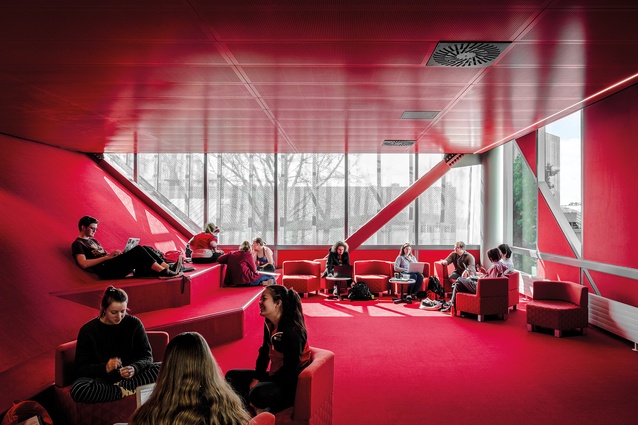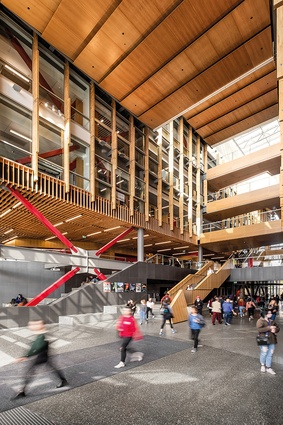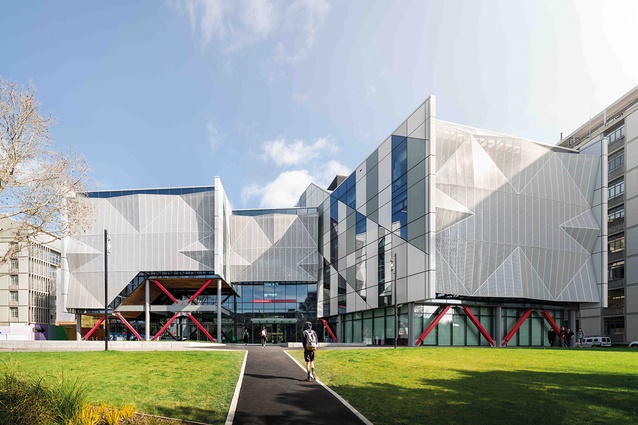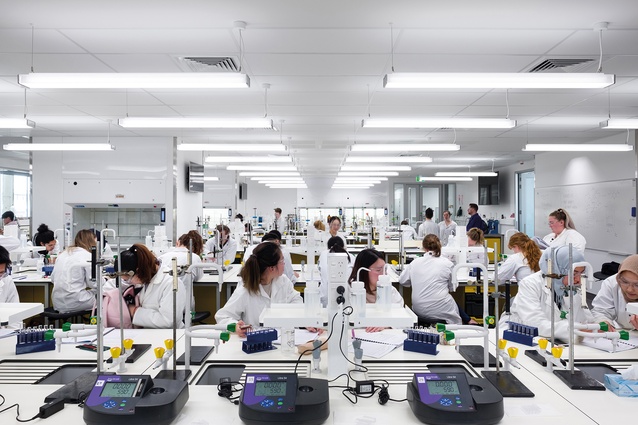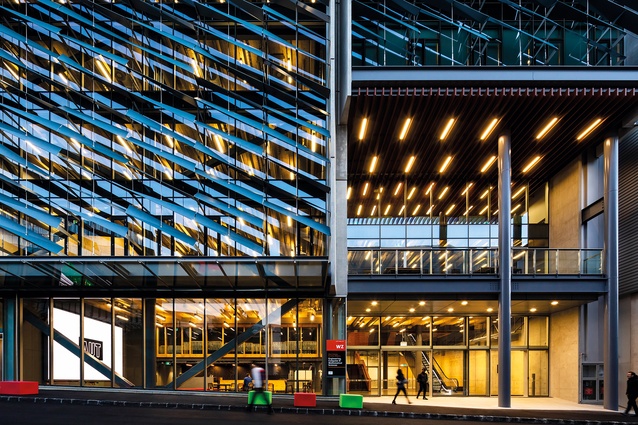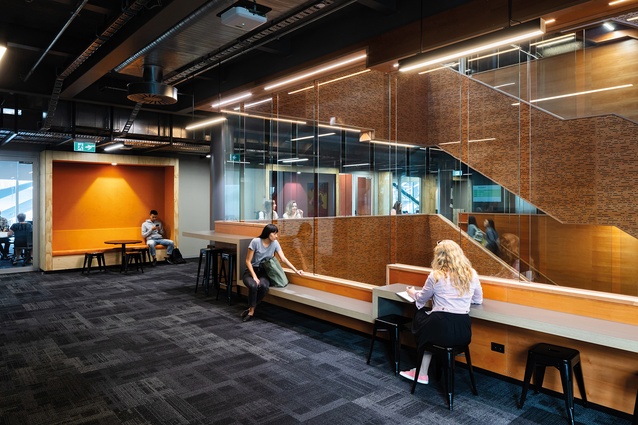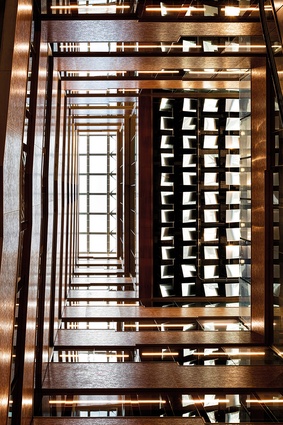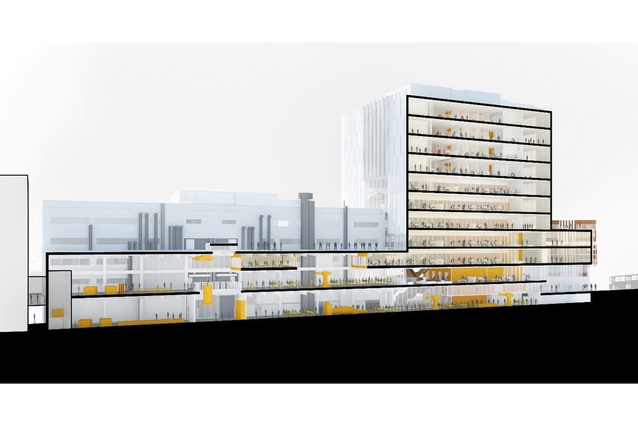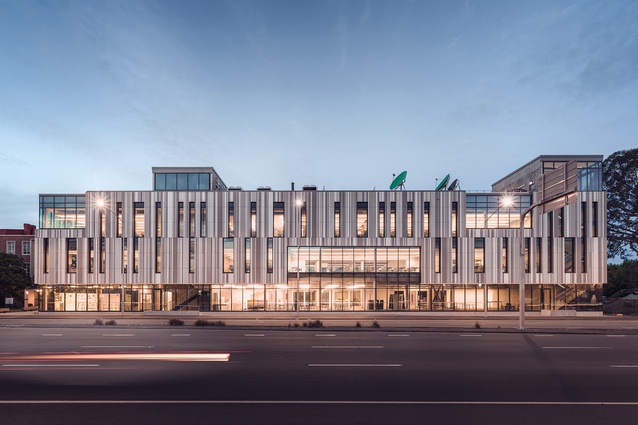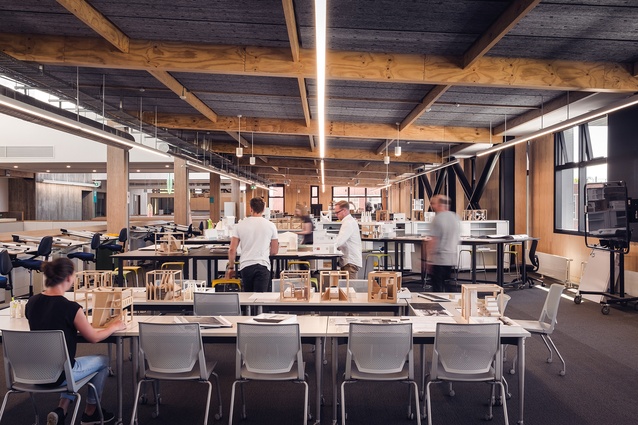Cathedrals of learning
Mary Henry reflects on three recent Jasmax tertiary education designs that respond to the evolution of the tertiary education sector, its contradictory drivers of physical and virtual environments and the ways in which universities encourage students to stay on campus.
“In the end, it all comes down to people and values… the best parts of human nature – creativity, empathy, stewardship – can also lift humanity into a new collective and moral consciousness based on a shared sense of destiny. It is incumbent on us all to make sure this prevails.” So says German economist Klaus Schwab in The Fourth Industrial Revolution: what it means, how to respond.1
As in so many sectors of society, disruptive forces are pressuring the tertiary education sector to evolve in order to maintain meaning and relevance. Fifty years from now, how will we define the role of a university in society? How will education be delivered? How will research be conducted? What will the nature and architecture of a university be?
A key challenge that continues to face our society – and which remains top of mind for many prospective students – is how we prepare our current and future workforces for a rapidly changing, unknown world. As big data, AI and automation are predicted to make many career paths obsolete, society will be challenged to re-educate a significant proportion of the current workforce and prepare students for pathways that don’t yet exist. As Alfin Toppler said in Future Shock, “The illiterate of the 21st century will not be those who cannot read and write, but those who cannot learn, unlearn and relearn.”
Globally, education sectors continue to turn to new pedagogies as well as new types of physical and virtual environments to address these challenges. Universities are focusing on key differentiators designed to appeal to student values and aspirations while recognising that learning experiences are intimately connected to life circumstances. Universities understand that not every learner is the same – and meeting the needs of individual students does not result in a one-size-fits-all education model or interface. Quality, cost, accessibility and choice are key for today’s students.
Many universities are exploring how they can better prepare students to become ‘lifelong learners’. They are also asking: ‘How can we build enduring relationships with our learners?’ Student populations will grow to include more mature and diverse groups, demanding greater flexibility in academic programmes. Universities are already responding by offering more bite-sized ‘nano-degrees’, more online training, corporate-tailored courses and more after-hours timetabled classes.
“To prosper, colleges need to become more like cathedrals,” says American higher education policy analyst. Kevin Carey.2 “They need to build beautiful places, real and virtual, that learners return to throughout their lives. They need to create authentic human communities and form relationships with people based on the never-ending project of learning… The idea of ‘applying to’ and ‘graduating from’ colleges won’t make as much sense in the future. People will join colleges and other learning organisations for as long or as little time as they need.”
To better meet the needs of their students, universities are balancing contradictory drivers with regards to the quality of physical and virtual environments. The demand for campus-based experiences – where students are immersed in the intellectual and social culture of university life – is competing with remote and virtual learning models delivered at a lower cost, with the added benefits of greater flexibility and accessibility.
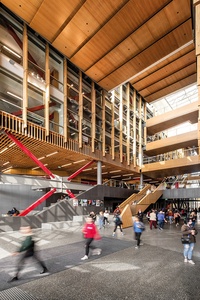
It will be interesting in the coming decades to observe just how much of the physical campus will be replaced or transformed by online learning platforms and technologies such as VR and AR. Perhaps it will go only so far; for example laboratory experiments may move into the virtual space, allowing existing highly specialised spaces to be adapted to fill other needs. Or will this technology become so immersive and pervasive that it will also permeate the social, peer-to-peer learning that students do, allowing them to get benefits traditionally found in the physical campus from the comfort of their own home?
At least for now, there is no doubt that a fulfilling on-campus experience is a key part of what many students look for in a university. Not only is the campus environment a means by which universities initially attract students, but research continues to prove a causal link between how long students spend on campus and how well they succeed academically.
So, how do universities encourage students to stay on campus? Outmoded ‘monocultural’ buildings continue to be replaced with engaging, flexible, multi-purpose and highly utilisable architecture, which supports more hands-on, peer-to-peer and collaborative learning. Buildings are designed to connect students more effectively with one another and with student services, academic staff, research and career pathways, plus their community and the world beyond.
An ongoing trend is increasing investment in the quantity and quality of un-programmed social learning space. Typically, these are attractive, informal, comfortable learning spaces where students can study alongside one another or together in groups.
Other trends include master plans promoting connection with nature; emphasis on design to support mental and physical health and well-being; greater provision for public transport, walking and cycling; inclusive spaces respecting diverse ethnic, religious, parental, age and gender needs; campus buildings that are more expressive of indigenous cultural identity and place; and greater choice in accommodation typologies. Universities are also investing in energy-efficient and sustainable buildings for both ethical and operational reasons.
Today’s modern campus buildings need to be flexible and adaptable to allow for ongoing changes in curriculum and technology. Buildings themselves are being designed as learning tools or ‘living laboratories’. Experiential learning spaces supported by technology and support staff, such as VR labs, are on the rise; maker spaces and project spaces are becoming common, as is the inclusion of quiet study or reading rooms, bookable group meeting and presentation spaces, and discursive lecture theatres that draw on ‘flipped classroom’ pedagogical models.
Today’s students want their choices to align with their values and the effect of this is being felt in many consumer markets – including tertiary education. Universities understand environmental responsibility and therefore sustainable campus design will continue to be a key differentiator.
Ernest Rutherford Building
Opened in 2018, the University of Canterbury’s Ernest Rutherford building is the university’s first major re-build project following the catastrophic earthquakes in Christchurch. The facility, intended to enable the university to ‘innovate and shape tomorrow’s science’, is unique in Australasia for combining six different science disciplines under one roof.
The key design challenge facing the university after the earthquakes was how to consolidate previously dispersed and independently operating schools from the College of Science within a smaller, more energy-efficient physical footprint.
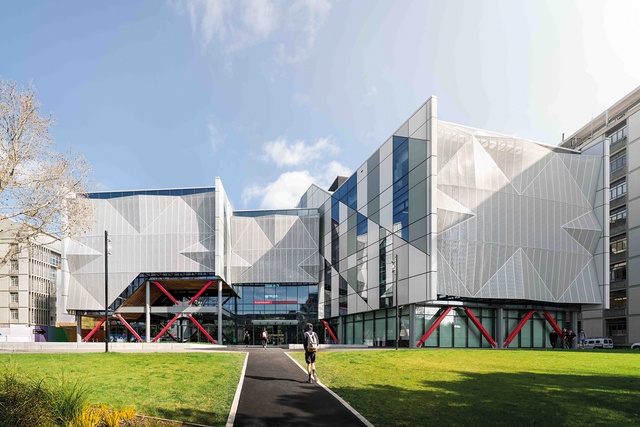
The brief from the university was: “Get us closer to students. Bring teaching closer to research.” The university believes science students need to be exposed to all learning and research pathways available to them, and to be inspired by the science happening all around them. For this reason, a large atrium cuts through all levels of the building, exposing students to other disciplines working on different levels. Walls into labs are typically fully glazed, as are specialist research labs, putting equipment and experimental processes on display.
The building provides access to a wide variety of informal learning spaces, hugely enhancing collegial and social opportunities. Spaces for staff and students to meet, work and relax make it a vibrant hub that attracts students from all over the campus.
It has also been designed to adapt to anticipated increases in automation in science, with a predominance of mid-sized, generic labs that can change in function over time. The multidisciplinary teaching laboratories are next-generation learning spaces – flexible, future-proofed and accessible.
A blended learning design approach has been used to support students working in more self-directed ways. Blended learning includes elements of self-directed research and reading prior to labs and in the write up of labs, using online material. Students are in the laboratory for shorter periods than is traditional, moving out of the lab as soon as their experimental work is complete to write up the results in informal study spaces surrounding the labs.
The building design also reflects a strong cultural identity and is expressive of its location in Waitaha Takiwā, Canterbury. The cultural concepts reflected in the architecture include Kia Atawhai ki te Iwi (Care for the People), Te Ara a Tawhaki (The Pathway of Knowledge) and Mahinga Kai (Care for the Land). These were developed in consultation with local iwi Ngāi Tahu.
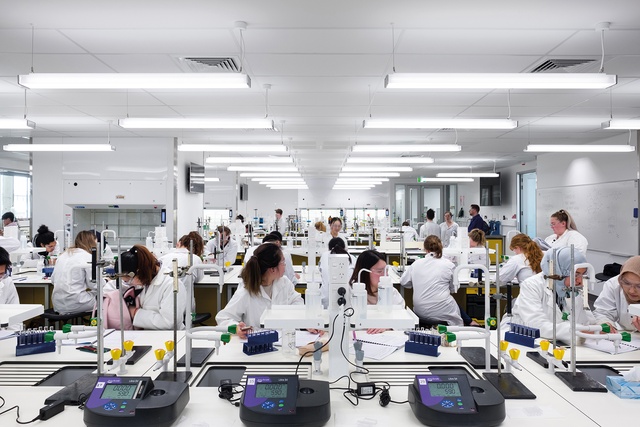
The five-story atrium space in particular reflects the concept of Te Ara a Tawhaki (The Pathway of Knowledge) and symbolises perseverance and striving for excellence in academia. Encouraging movement up through the levels of the building, the atrium is reflective of the Māori deity Tāwhaki’s advancement through different strata of learning.
The diagonal façade panel design both replicates the building’s braced structure and mimics tukutuku weaving patterns, acknowledging the importance of the site as a settlement area for Ngāi Tahu and place of mahinga kai (food gathering).
Ngā Wai Hono
Also opened in 2018, Ngā Wai Hono is the latest addition to AUT’s City Campus and has enabled the amalgamation of Engineering, Computer and Mathematical Sciences (ECMS) into a consolidated facility interconnected with adjacent campus buildings. This super-sized development encourages greater interaction and visibility between the neighbouring faculties of Art and Design and Applied Sciences.
The building is conceived as a tool for learning and research and so, inside Ngā Wai Hono, the structure and services of the building are proudly on display. Students can test the theory they learn on the building itself. For example, undergraduates in mechanical and electrical engineering can alter air conditioning systems in one of the project studio spaces to compare and contrast how different systems, including fan coil, chilled beam and variable air volume, perform. Students also have access to data from the building management system to help them develop an understanding of power and water consumption relating to different services such as lighting and air conditioning.
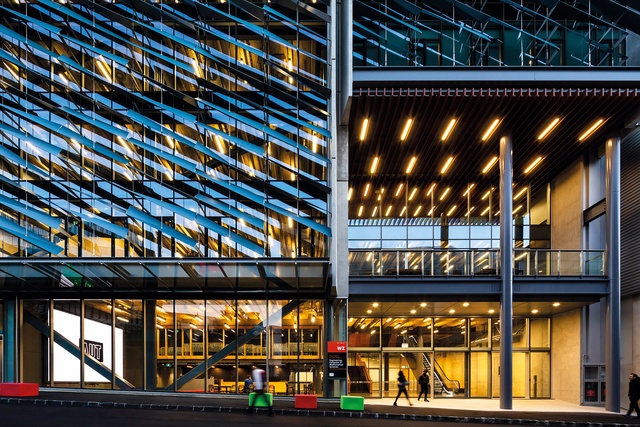
“I’m sure most of us, if we get stuck over something or other, we just look up and see if we can find the same thing,” says Engineering: Built Environment PhD candidate Purushothaman Mahesh Babu. “Sometimes you find undergraduates or master’s graduates asking you certain questions and you say ‘Look – that is there, fixed up, that is how it is done.”
AUT’s pedagogical model supports student-led, hands-on learning styles and the building prioritises a generic, loose-fit/long-life, flexible and adaptable approach to space design. For example, large-format ‘Flexible Delivery Labs’ are designed for a spectrum of wet-to-dry, dirty-to-clean teaching activities. Furniture and equipment used in these spaces is on wheels to enable them to be set up for programmed teaching modules, with palletised experiments able to be changed in and out as the curriculum demands.
Ngā Wai Hono builds upon strategies used in AUT’s other campus developments, creating an interconnected, socially activated facility with plenty of informal student learning spaces. It invites the public to use the building both as a meeting place and as a shortcut for walking across campus. Cafés, primary circulation and community and business engagement spaces all overlook teaching and research activities to showcase AUT.
Kahukura
One of the greenest buildings in the Canterbury reconstruction programme, Ara Institute of Canterbury’s three-storeyed, 6500-square-metre architecture and engineering building, Kahukura, like Ngā Wai Hono, has been designed with the structure, services and construction materials on display, acting as a learning opportunity for the students who study inside.
The lightweight structural frame uses laminated veneer lumber (LVL) timber. Inside, the building also features linings of both engineered plantation pine and sustainably grown New Zealand black-butt eucalyptus. The building, opened in 2017, was constructed in a modular system, using 3D modelling of timber elements to allow for offsite production of the LVL frame elements and cross-laminated timber (CLT) façade panels. Timber balustrades, stair bleachers and joinery imbue the building with warmth. Careful detailing, light, lofty spaces and natural, fresh air ventilation combine to provide a comfortable atmosphere.
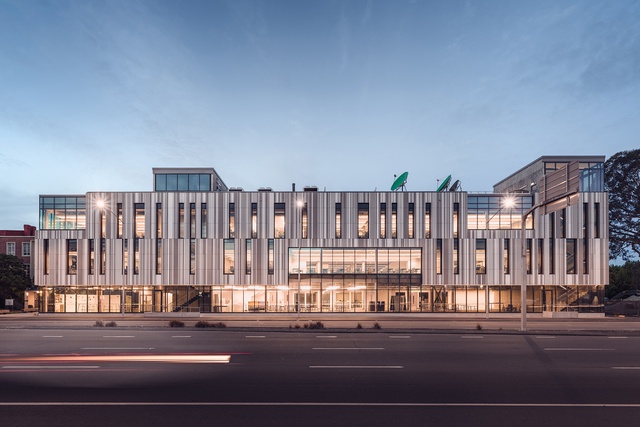
The predominant use of timber supports the sustainability aspirations of the university and allows a large amount of carbon to be sequestered within the building. Other sustainable design features include: natural-light-filled atria and learning spaces; mixed-mode natural ventilation through most spaces; 400 photovoltaic panels that are anticipated to generate 40 per cent of the building’s energy load; toxic-free material choices, with nearly all materials free of chemicals listed in the Living Building Challenge’s ‘Red List’; and a reduction of water use by 50 per cent relative to the previous facility.
The cultural narrative of the building’s façade design is generated by the idea of a kahukura (a chiefly cloak): a metaphor that references the Port Hills and was developed alongside Ara’s Te Puna Wānaka team and local iwi. The high-performance façade is also intended as a practical metaphor for the protection of those who are inside, conferring mana on the students.
References
1 Schwab, Klaus. The Fourth Industrial Revolution: what it means, how to respond, 2016.
2 Carey, Kevin. The End of College: Creating the Future of Learning and the University of Everywhere, 2015.
This article first appeared in Architecture New Zealand magazine.


